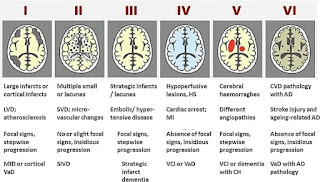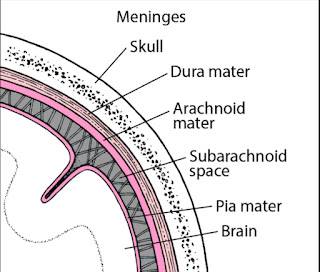BIMONTHLY ASSIGNMENT
Detailed patient case report here: http://ushaindurthi.blogspot.com/2020/11/55-year-old-male-with-complaints-of.html
1. What is the problem representation of this patient and what could be the anatomical site of lesion ?
A.55 Y M patient who is a mestri worker came with c/o inability to move his right upper limb and episodes of seizures.He is a chronic alcoholic and beedi smoker since 35 years.
Lesions may be seen in left fronto parietal temporal and occipital lobes.mostly temporal region.
2. Why are subcortical internal capsular infarcts more common that cortical infarcts?
A.
small subcortical infarcts (RSSIs) mostly result from the occlusion of a single, small, brain artery due to intrinsic cerebral small-vessel disease (CSVD). Some RSSIs may be attributable to other causes such as cardiac embolism or large-artery disease, and their association with coexisting CSVD and vascular risk factors may vary with morphological magnetic resonance imaging (MRI) features.
https://pubmed.ncbi.nlm.nih.gov/26043763/

3. What is the pathogenesis involved in cerebral infarct related seizures?
A.
4. What is your take on the ecg? And do you agree with the treating team on starting the patient on Enoxaparin?
A. Ventricular ectopics seen
ST depressions noted in precordial leads V1 to V6
[ ] https://www.ahajournals.org/doi/full/10.1161/STROKEAHA.109.555003#:~:text=Background%20and%20Purpose%E2%80%94%20The%20Prevention,but%20statistically%20significant%20increase%20in
5. Which AED would you prefer?
If so why?
Antiepileptics:
The latest ILAE report recommends that for efficacy, as initial monotherapy in adults with focal seizures, carbamazepine (CBZ), levetiracetam (LEV), phenytoin (PHT) and zonisamide have level A evidence. For elderly patients, lamotrigine (LTG) and gabapentin (GBP) have level A evidence.71 In the Standard and New Antiepileptic Drugs (SANAD) trial, the efficacy and tolerance were compared among GBP, LTG, oxcarbazepine (OCBZ) and topiramate in patients with partial epilepsy. GBP was found to be less effective and LTG was better tolerated than the other drugs.72 In the Keppra vs Older Monotherapy in Epilepsy Trial (KOMET trial, LEV, valproic acid (VPA) and CBZ were compared as initial monotherapy in elderly patients (>60 years old). It was found that LEV had better tolerance and less severe treatment withdrawal effects than other AEDs, but no difference was detected in drug efficacy.
Patient details in the intern logged online case report here: http://manojkumar1008.blogspot.com/2020/12/shortness-of-breath-with-high-sugars.html
Questions:
1. What is the problem representation for this patient?
A.55Y M patient with DM II and HTN since 10 years and on medications came with c/o sudden onset dizziness,profuse sweating,secondary to OHA induced hypoglycemia, exertional dyspnea and cough with no sputum. since 3 days
2. What is the cause for his recurrent hypoglycemia? And how would you evaluate?
A.https://www.researchgate.net/publication/23669098_Drug-Induced_Hypoglycemia_A_Systematic_Review
May be due to drug over dose and alcohol intake.
Alcohol causes increased sugar levels, in the blood leading to increased insulin release leading to hypoglycaemia.
3. What is the cause for his Dyspnea? What is the reason for his albumin loss?
A. DYSPNEA:
4. What is the pathogenesis involved in hypoglycemia ?
A.
A. 41 year old man with Polyarthralgia
Case details here: https://mahathireddybandari.blogspot.com/2020/11/41m-with-chest-pain-and-joint-pains.html?m=1
1. How would you evaluate further this patient with Polyarthralgia?
A.
2. What is the pathogenesis involved in RA?
A.
3. What are the treatment regimens for a patient with RA and their efficacies?
A.
The following abbreviations and nomenclature for disease-modifying antirheumatic drugs (DMARDs) were used in this document:
csDMARD: conventional synthetic disease-modifying antirheumatic drugs - methotrexate, leflunomide, sulfasalazine, and antimalarial drugs (hydroxychloroquine and chloroquine).
tsDMARD: synthetic target-specific disease-modifying antirheumatic drug - tofacitinib.
bDMARD: biological disease-modifying antirheumatic drugs - tumor necrosis factor inhibitors/TNFi (adalimumab, certolizumab, etanercept, golimumab, infliximab), T-lymphocyte co-stimulation modulator (abatacept), anti-CD20 (rituximab), and IL-6 receptor blocker (tocilizumab).
boDMARD: original biological disease-modifying antirheumatic drugs.
bsDMARD: biosimilar biological disease-modifying antirheumatic drugs.
https://www.hopkinsarthritis.org/arthritis-info/rheumatoid-arthritis/ra-treatment/
75 year old woman with post operative hepatitis following blood transfusion
Case details here: https://bandaru17jyothsna.blogspot.com/2020/11/this-is-online-e-log-book-to-discuss.html
1.What are your differentials for this patient and how would you evaluate?
A.Post transfusion delayed hemolytic reaction
Evaluation:
ABO and Rh compatability
coombs testing
antibody panel testing
https://www.learnhaem.com/courses/frcpath-transfusion/lessons/antibody-screening-and-identification/topic/antigrams/
-Transfusion related acute hepatic injury (TRAHI)
-Post transfusion hepatitis
-Ischemic hepatitis
Evaluation:
2. What would be your treatment approach? Do you agree with the treatment provided by the treating team and why? What are their efficacies?
Symptomatic management:
I agree with the treatment provided by the treating team
Lasix & Nebulization : For wheezing and crepts
Lactulose :https://pubmed.ncbi.nlm.nih.gov/27089005/
Zofer : For vomitings
Pantop : To prevent gastritis
http://manojkumar1008.
1. What is the problem representation of this patient?
A 60 year old female with T2DM & HTN since 2 years c/o pricking type of chest pain since 4 days and uncontrolled sugars secondary to ? right upper lobe pneumonic consolidation with sepsis
2. What are the factors contributing to her uncontrolled blood sugars?
Hyperdense area noted in the right upper lobe
4. What do you think is the cause for her hypoalbuminaemia? How would you approach it?
- Inflammation (acute phase reactant)
- Malnutrition
- Albuminuria (protein losing nephropathy)
- Piptaz & clarithromycin : for his right upper lobe pneumonic consolidation and sepsis
- Egg white & protien powder : for hypoalbuminemia
- Lactulose : for constipation
- Actrapid / Mixtard : for hyperglycemia
- Tramadol : for pain management
- Pantop : to prevent gastritis
- Zofer : to prevent vomitings
Case report here: https://appalaaishwaryareddy.blogspot.com/2020/11/56year-old-male-with-decompensated.html
1. What is the anatomical and pathological localization of the problem?
A.Liver : Chronic liver disease (cirrhosis) secondary to HBV
A.
3. What is the pathogenesis of the illness due to Hepatitis B?
A.Hepatitis B?
4. Is it necessary to have a separate haemodialysis set up for hepatits B patients and why?
A.
A.
- Lactulose : for prevention and treatment of hepatic encephalopathy. https://pubmed.ncbi.nlm.nih.gov/27089005/
- Tenofovir : for HBV
- Lasix : for fluid overload (AKI on CKD) https://www.ncbi.nlm.nih.gov/books/NBK499921/#:~:text=The%20Food%20and%20Drug%20Administration,failure%20including%20the%20nephrotic%20syndrome.
- Vitamin -k : for ? Deranged coagulation profile (PT , INR & APTT reports not available)
- Pantop : for gastritis
- Zofer : to prevent vomitings
- Monocef (ceftriaxone) : for AKI (? renal)
Case report details: http://
1. What is the problem representation of this patient?
A 58 year old weaver occasional alcoholic c/o slurring of speech , deviation of mouth to right side associated with drooling of saliva , food particles and water predominantly from left angle of mouth and smacking of lips since 6 months.
2. How would you evaluate further this patient with Dementia?
4. What is the likely pathogenesis of this patient's dementia?
A. PHARMACOLOGIC:
Cholinesterase inhibitors:
Donepezil
Rivastigmine
Galantamine
NMDA antagonist:
Memantine
NON PHARMACOLOGIC:
Counselling the patient and care givers
Geriatric care
Cognitive / emotion oriented interventions
Sensory stimulation interventions
Behaviour management techniques.
Case report here http://geethagugloth.
1. What is the problem representation of this patient ? What is the anatomic and pathologic localization in view of the clinical and radiological findings?
A paradoxical clinical worsening of a known condition or the appearance of a new condition after initiating anti retroviral therapy (ART) therapy in HIV-infected patients resulting from restored immunity to specific infectious or non-infectious antigens is defined as immune reconstitution inflammatory syndrome (IRIS).
As his CD4 count is > 50 /mm3 consider delayed initiation of ART ideally after 8 weeks of starting ATT to reduce the chances of developing IRIS




























Comments
Post a Comment